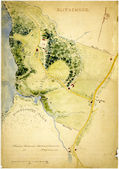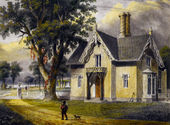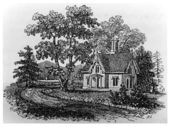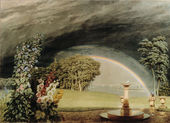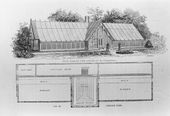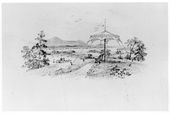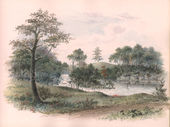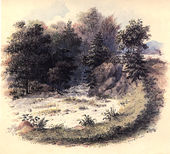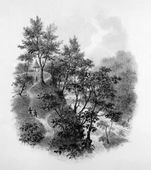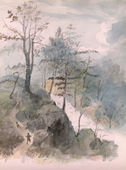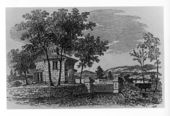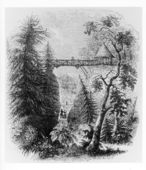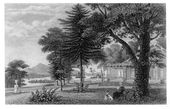Blithewood
Overview
Alternate Names: Mill Hill; Annandale; Annandale-on-Hudson; Blithe Wood; Blythe Wood; Blithwood; Blythewood
Site Dates: 1795 to present
Site Owner(s): Barent van Benthuysen (1725–1795?); John and Alida Livingston Armstrong (1795–1801); John and Mary Johnston Allen (1801–1810); John Cox Stevens and Maria Cambridge Livingston (1810–1833); John Church Cruger (1833–1835); Robert and Susan Gaston Donaldson (1835–1853); John and Margaret Johnston Bard (1853–1897); Saint Stephen’s College (1897–1899); Captain Andrew Christian and Frances Hunter Zabriskie (1899–1916); Frances Hunter Zabriskie (1916–1951); Bard College (1951–present)
Associated People: Walter Elder (gardener), George Kidd (gardener), Andrew Jackson Downing (landscape gardener), Alexander Jackson Davis (architect), Hans Jacob Ehlers (landscape gardener)
Location: Dutchess County, NY
Condition: altered
View on Google maps
History
Between 1795 and 1836 the property that would come to be known as Blithewood exchanged hands several times. Several of its owners were connected by birth or by marriage to the Livingston and Armstrong families. In 1795, the soldier and politician John Armstrong (1758–1843) and his wife Alida Livingston Armstrong (1761–1822) purchased a 125 acre estate, which they named Mill Hill. The Armstrongs built a Federal-style house on the property and developed the land as a farm. John and Mary Johnston Allen bought the estate in 1801, which they called Annandale after the Scottish ancestral home of Mary’s family. In 1810, John Cox Stevens (1785–1857), best known as the founder of the New York Yacht Club, and his wife Maria Cambridge Livingston (1799–1865) acquired the property. Stevens was later credited with planting some of the most impressive trees on the estate. One 1856 article went so far as to call his trees “a successful instance of planting attaining perfection in the lifetime of a single individual” (view text). In 1833, the lawyer John Church Cruger purchased Mill Hill and the adjacent peninsula, on which he built his own country seat, known as Cruger’s Island. Two years later, in 1835, Cruger sold the southern part of his property to the banker Robert Donaldson (1800–1872) and his wife Susan Gaston (1808–1866), who renamed the estate Blithewood.
Upon purchasing the estate, Donaldson hired the architect Alexander Jackson Davis (1803–1892) to renovate the existing house as an ornamental cottage, and design a new gatehouse, later used as a gardener’s house. Davis and Donaldson collaborated closely on the design, and the two would go on to create other outbuildings for Blithewood including a spring house, an Egyptian revival toolhouse, assorted picturesque seats, and a hermitage.[1] Their collaborations are well illustrated by Davis’s many surviving ink and watercolor preparatory drawings [fig. __]. In 1841, Davis negotiated a joint purchase of the Sawkill creek, which ran between Blithewood and its neighboring estate, Louise Livingston’s Montgomery Place, to ensure that the southern border of his property would not be marred by “the countless vexations & annoyances of Factories.”[2] That same year, Blithewood received lavish praise in the first edition of Downing’s Treatise on the Theory and Practice of Landscape Gardening, a description which was quickly reprinted abroad in respected journals like John Claudius Loudon’s The Gardener's Magazine. Downing described “delightful walks leading in easy curves to rustic seats, summer houses, etc. disposed in secluded spots, or to openings affording the most lovely prospects,” and “Maltese vases” that were “disposed in such a manner as to give a classic air to the grounds” (view text). The rustic, picturesque aesthetic was complemented by the gothic-influenced “English cottage style” of Donaldson’s early additions.
—Alexander Brey
Images
- ↑ For the collaboration between Donaldson and Davis, see Jean Bradley Anderson, Carolinian on the Hudson: The Life of Robert Donaldson (Raleigh: Historic Preservation Foundation of North Carolina, 1996), 169.
- ↑ For the negotiations between Donaldson, Livingston, and John C. Cruger, who owned the Sawkill property, see Anderson, 173–75.
